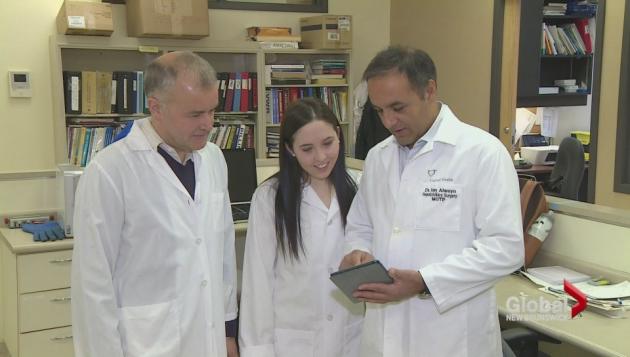This disease has not been talked about and it is certainly not good for you. The problem with all this thouigh is that what we do know is largely bunkem based on assumptions that are untested and unproven. We do know that it is part of the cardiovascular syndrome that ninety percent of the population suffers from.
That is also explained away through far too much cause and effect arguments that are debatable.
What is interesting here is that they are looking for flushing agents. These agents may be usable on organs still in the body long before a partial transplant is attempted. In the meantime we will watch closely.
Fatty liver disease an epidemic few know
Fatty liver disease may not be well known, but it's epidemic. You could be among the millions of Canadians who unknowingly have it.
Caused mainly by a poor diet and a lack of exercise, the condition has now surpassed alcohol as the leading cause of liver disease in Western nations, doctors say.
"As a radiologist, I see fatty livers almost every day," says Dr. Sharon Clarke, an assistant professor with the department of diagnostic radiology at Dalhousie University in Halifax.
"Patients often come in for an imaging test for some other reason and we incidentally notice that they have fatty liver."
In the Atlantic provinces where obesity rates are higher than other regions, up to 40 per cent of the population has fatty liver disease. It's a serious condition because it can lead to much more serious health problems such as cirrhosis, fibrosis or cancer.
Among the sufferers is Loman Ayer, a 66-year-old retired provincial government worker in Shelburne, N.S. He had fatty liver disease that has led to liver cancer.
"Every once and awhile, I can hear my family doctor tell me, 'You got to lose weight, you got to lose weight!' But I didn't do it and I should have."
Ayer says now he's paying the price for the years he indulged in "breads and sweets."
"I'm on the list for a liver transplant and if I don't get a new liver, then I'm gonna die much sooner than when I should because there's no cure for my cancer."
Research project
The prevalence of fatty liver disease has prompted a team of doctors in Halifax to begin a research project.
One of the main challenges when it comes to fatty liver disease and transplants is there's a high chance the donor liver will also have the condition.
"If we transplant livers that are fatty, we know that the outcomes are poor," says Dr. Ian Alwayn, a transplant surgeon and an associate professor with the general surgery division at Dalhousie University.
Alwayn and his team will experiment to try to "de-fat" a fatty liver after it has been donated.
"We've developed technologies that allow us to store the liver on a pump," he says.
"We have a system that profuses or pumps fluid through the liver, through the blood vessels in the liver. To that solution, we will be adding agents that act on short-term lipid metabolism. So they actually help the liver get rid of its fat by itself and flush it through the bile ducts or through the blood system."
Alwayn says the window of opportunity to de-fat a liver is small. "We have about four to six hours, we think, that we can use these pumps to de-fat livers. It has to be a short-acting and fast-acting agent."
Alwayn says the liquid that's pumped through the liver will contain a preservation solution along with nutrients and oxygen at body temperature. Specific compounds will be added to the solution to help remove fat from the liver.
"Even if we can remove the fat of a very severely fatty liver to become mildly fatty that would still allow us to use that liver for transplant purposes."
De-fatting experiments
The biggest challenge will be to identify which agents work best at de-fatting, an exciting prospect for Alwayn.
"I believe this truly is a way that we would be able to use more organs, more livers for transplantation and help more people."
Better diagnosis is another aspect of the research. MRI has always been able to detect a fatty liver, but the Halifax Infirmary now has a powerful new MRI to not only show when a liver is fatty, but also reveal what kind of fat is in the liver and how much inflammation there is.
Clarke says having both a fatty liver and inflammation is a bad combination. Currently, the only way to properly diagnose a fatty liver is to do a biopsy.
"It has complications such as infection, pain and bleeding. And also, fatty liver disease is so prevalent that it's not practical to have every single person have a biopsy," she says.
"Having a non-invasive way to assess these people would be very helpful not only for diagnosis, but for monitoring the effects of treatment over time."
Early and more accurate diagnoses are important because once a patient finds out he or she has fatty liver disease, they can change their eating habits and begin an exercise regime that may help ease the problem.
Waiting for a transplant
Even when he takes his dogs for a walk, Ayer keeps his cellphone with him because a call could come at any moment, letting him know a donor organ is available.
"I keep the gas tank full too," he says.
Ayer just got on the transplant list last week after a rigourous process. Now, it's an anxious waiting game.
He says a cancer diagnosis is always a shock and it's stressful, but he's not giving up.
He does have advice for others about their eating habits and how much exercise they get: "You don't get away with these things forever."

No comments:
Post a Comment